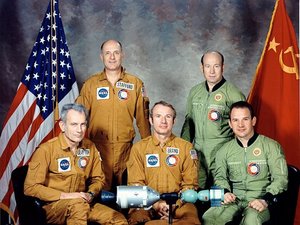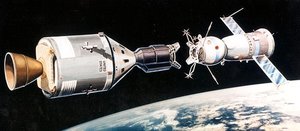Apollo-Soyuz Test Project
|
|
| Mission Spacecraft | |
|---|---|
| Mission Statistics (Soyuz) | |
| Mission Name: | Soyuz 19 |
| Call Sign: | Союз (Soyuz - "Union") |
| Number of Crew: | 2 |
| Launch: | July 15, 1975 12:20:00 UTC Baikonur |
| Apogee: | 231 km |
| Perigee: | 218 km |
| Period: | 88.92 min |
| Inclination: | 51.76 deg |
| Landing: | July 21, 1975 10:50:00 UTC 57° N 67° E |
| Duration: | 5 d 22 h 30 min 54 s |
| Number of Orbits: | 96 |
| Distance Traveled: | ~2,400,000 mi (~3,900,000 km) |
| Mass: | Soyuz 6,790 kg |
| Mission Insignia | |
Missing image ASTPpatch.png Apollo-Soyuz insignia | |
| Mission Statistics (Apollo) | |
| Mission Name: | Apollo |
| Call Sign: | Apollo |
| Number of Crew: | 3 |
| Launch: | July 15, 1975 19:50:00 UTC Kennedy Space Center LC-39B |
| Apogee: | 231 km |
| Perigee: | 217 km |
| Period: | 88.91 min |
| Inclination: | 51.75 deg |
| Landing: | July 24, 1975 21:18:00 UTC Template:Coor dm |
| Duration: | 9 d 1 h 28 min 24 s |
| Number of Orbits: | 148 |
| Distance Traveled: | ~3,700,000 mi (~5,990,000 km) |
| Mass: | CSM 14,768 kg DM 2,012 kg |
| Crew Picture | |
 ASTP crew portrait (L-R: Slayton, Stafford, Brand, Leonov, Kubasov) | |
| ASTP Crew | |
The Apollo-Soyuz Test Project was the first joint flight of the US and Soviet space programs. The Apollo Spacecraft and Docking Module were launched on a Saturn IB rocket.
| Contents |
Apollo Crew
- Thomas Stafford (flew on Gemini 6A, Gemini 9A, Apollo 10, & Apollo-Soyuz) - Apollo Commander
- Vance Brand (flew on Apollo-Soyuz, STS-5, STS-41-B, & STS-35) - Apollo Command Module Pilot
- Deke Slayton (flew on Apollo-Soyuz) - Apollo Docking Module Pilot
(1) number of spaceflights each crew member has completed, including this mission.
Jack Swigert had originally been suggested for Command Module Pilot position in the original ASTP prime crew, but was removed as punishment for his role in the postage stamp scandal following the Apollo 15 mission. (Swigert was not involved in the controversial Apollo 15 stamp deal, but in the investigation that followed the scandal he initially denied having any involvement in similar schemes. When evidence against him started to build up he confessed to Deke Slayton and was consequently considered to be undesirable from a public relations viewpoint.)
Backup Crew
Support Crew
Soyuz Crew
- Alexei Leonov (2) - Soyuz 19 Commander
- Valery Kubasov (2) - Soyuz 19 Engineer
(1) number of spaceflights each crew member has completed, including this mission.
Backup Crew
Mission parameters
- Mass:
- 14,768 kg (Apollo),
- 6,790 kg (Soyuz)
- Perigee:
- 152 km (Apollo),
- 186 km (Soyuz)
- Apogee:
- 166 km (Apollo),
- 220 km (Soyuz)
- Inclination:
- 51.7° (Apollo),
- 51.8° (Soyuz)
- Period:
- 87.6 minutes (Apollo),
- 88.5 minutes (Soyuz)
Docking
- First Docking: July 17, 1975 - 16:19:09 UTC
- Last Undocking: July 19, 1975 - 15:26:12 UTC
- Time Docked: 1 day, 23 hours, 07 minutes, 03 seconds
Mission highlights
The Apollo-Soyuz Test Project (ASTP) took place in the second half of July 1975 and entailed the docking of an American Apollo space craft with the Soviet Soyuz 19 space craft. The former had three crew on board – Tom Stafford, Vance Brand and Deke Slayton, the latter had two – Alexei Leonov and Valery Kubasov.
ASTP was in part inspired by the 1968 film Marooned, in which a stranded US Apollo crew is rescued by a Soviet spacecraft. Although the equipment developed for ASTP was only of use as a one-off, the program allowed NASA to maintain a manned space focus following the end of the Apollo and Skylab missions. As the Saturn IB launcher and Apollo CSM were all surplus materiel, ASTP was the most inexpensive manned space program ever mounted.
The Soyuz 19 and Apollo craft launched within seven-and-a-half hours of each other July 15, and docked on July 17. Three hours later, Stafford and Leonov exchanged the first international handshake in space through the open hatch of the Soyuz. The two spacecraft remained linked for 44 hours, long enough for the three Americans and two Soviets to exchange flags and gifts (including tree seeds which were later planted in the two countries), sign certificates, pay visits to each other's ships, eat together and converse in each other's languages. There were also docking and redocking maneuvers during which the two spacecraft reversed roles and the Soyuz became the "active" ship. The Soviets remained in space for five days, the Americans for nine, during which the Soviets also conducted experiments in Earth observation.
Soyuz_19_(Apollo_Soyuz_Test_Project)_spacecraft.jpg
The docking was made possible by a specially-built adapter that was carried into orbit with the Apollo craft and took place on July 17, 1975. The historic handshake between Stafford and Leonov, the two mission commanders, had originally been scheduled at such time that it would have taken place over Bognor Regis, but a delay resulted in its actual occurrence being over continental Europe.
While docked, the two crews conducted joint scientific experiments and spent time in each others' craft. After forty-four hours together, the two ships separated, and maneuvered to use the Apollo to create an artificial solar eclipse to allow the crew of the Soyuz to take photographs of the solar corona. Another brief docking was made before the ships went their separate ways.
The mission was a great success, both technically and as a public-relations exercise for both sides. As an aside, the Apollo-Soyuz mission was the first mission carrying a handheld programmable pocket calculator (the HP-65); the calculator was programmed to perform several backup computations to partly stand in for the Apollo mission computer in case the latter should malfunction or cease to function altogether (neither of which occurred).
The only serious problem that arose was due to the Apollo crew making a mistake during their preparations for re-entry that resulted in a very rough landing and the capsule filling with noxious fumes. The reaction control system was inadvertently left on during descent, producing uncombusted thruster propellant which was then sucked into the capsule as its pressure equalized with the outside air. Fortunately, there were no serious injuries.
This was the final flight of an Apollo spacecraft. The Command Module is on display at Kennedy Space Center, Cape Canaveral, Florida.
Insignia
The ASTP insignia was cleverly designed. Look closely at the ASTP crew picture. The American crew wears the insignia with the "Blue" banner to the left. This causes the patch to read as "Apollo - Soyuz". The Soviet crew wears the insignia with the "Red" banner to the left. Worn this way, the patch now reads, "Soyuz - Apollo".
External links
- The Partnership: A History of the Apollo-Soyuz Test Project (http://www.hq.nasa.gov/office/pao/History/SP-4209/toc.htm)
– the official NASA history of the mission
- OMWorld's ASTP Docking Trainer Page (http://www.io.com/~o_m/ssh_forgotten_astp.html)
- International rendezvous and docking mission (Apollo-Soyuz/Salyut) 1971 - NASA report (PDF format) (http://ntrs.nasa.gov/archive/nasa/casi.ntrs.nasa.gov/19750067869_1975067869.pdf)
- Apollo/Soyuz test project operational data book. Volume 2: ASTP mass properties data book - NASA report (PDF format) (http://ntrs.nasa.gov/archive/nasa/casi.ntrs.nasa.gov/19730025080_1973025080.pdf)
| Preceded by: Skylab 4 | Project Apollo | Succeeded by: STS-1 |
| Preceded by: Soyuz 18 | Soyuz programme | Succeeded by: Soyuz 20 Template:US manned space programs Template:Russian manned space programs pt:Apollo 18 es:Apollo-Soyuz de:Apollo-Sojus-Projekt fr:Apollo-Soyouz he:אפולו-סויוז hu:Apollo-Szojuz-program |

